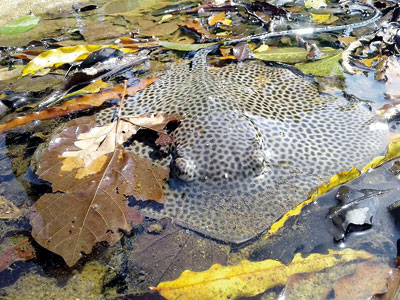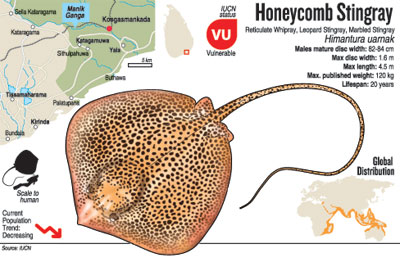News
Whip-tailed beauty spotted in Yala’s Menik Ganga
Yala is a paradise for spotted animals such as leopard and deer, but the spotty creature found last week in the Manik Ganga near Kosgasmankada was unusual.

The honeycomb stingray spotted in the Menik Ganga, pic courtesy Geemal Harold.
A party having a dip in the river’s shallows found a long-tailed creature with a disc-shaped body patterned with many small dark spots or reticulations. Biologist Rex I. De Silva identified the creature from a photograph sent to him by bather Geemal Harold as a honeycomb stingray or banded whiptail stingray (Himantura uarnak).
“The honeycomb stingray is a common marine species in our coastal waters but finding one in freshwater is unusual,” Mr. De Silva said.
The stingray is named after the barbed stinger on its long tail, which is primarily used in self-defence.
Rays and skates are flattened fish closely related to sharks. They do not have hard bones like other fish but a skeleton of flexible cartilage such as found in the human ear and nose.
Marine sharks and rays occasionally enter freshwater during spring tides, Mr. De Silva said. In times of drought, when river levels fall, seawater intrudes some distance up rivers at high and especially spring tides. Sharks and other marine species follow the seawater for a considerable distance upriver.
Shark sightings in the Menik Ganga have been recorded over the past 30 years but not sightings of rays.
The disc-shaped body of the honeycomb stingray found by Mr. Harold’s party was about 30.5cm (one foot) in diameter but the species can grow up to 2m (6.6 feet), so the one found in Yala would be a young stingray that decided to have an adventurous journey upstream.
The stingray’s tail, called “maduwa” in Sinhala, which can be three times its body length, was dried and used in olden times as a whip for punishment, the barbs on the tail inflicting great pain.
Rays are masters at bottom-dwelling. They have eyes on the top of their head/body and so relies on other senses in finding food (crustaceans, small fish, snails, shrimp etc.) on usually murky ocean beds.
Special organs on their face called ampulae allow them to navigate and find prey with electromagnetic signals.
Sadly, stingray numbers are in decline due to over-fishing, habitat loss and climate change. At present, 539 species of ray are on the International Union of Conservation of Nature’s (IUCN) Red List of endangered species, with 107 classified as threatened. The honeycomb stingray is categorised as “vulnerable”, making this Yala sighting special.


